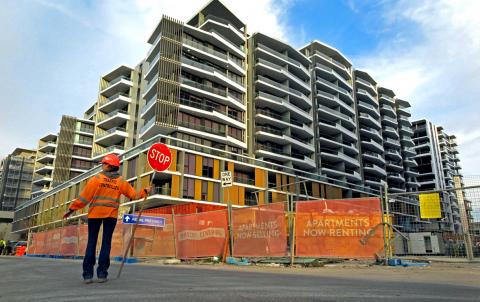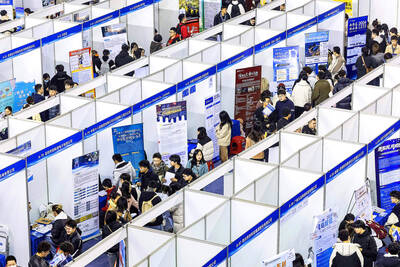Sydney is imposing new taxes on foreigners buying homes, as concerns grow that a flood of mostly Chinese investors is crowding out locals and killing the “Great Australian Dream” of owning property.
Ownership rates across the country are among the highest in developed nations, with having your own house long viewed as a key aspect of Australian identity.
However, as prices rise to record levels — Sydney is ranked second only to Hong Kong as major cities with the world’s least affordable housing — new potential homeowners have been increasingly forced out of the market with foreigners blamed as a key factor.

Photo: AFP
“The governments want to respond to a perception about housing affordability and the impact of foreign investment on that,” KPMG Australia’s indirect tax specialist Michelle Bennett told reporters.
“[Politicians] are raising money from people who aren’t voting, so superficially you can understand that it’s possibly not bad politics,” she added, but warned the measures could be a “blunt instrument” that could hurt the market.
Last year, leading apartment developer Lend Lease Corp sold out more than A$600 million (US$444 million) worth of new units in Sydney’s Darling Harbour in under five hours, with the Australian Financial Review reporting that one-third of buyers were foreign.
Lend Lease said the sale broke local records, but such reports have also fueled calls for government action to protect Australian buyers.
In response, the New South Wales, Victoria and Queensland state governments have introduced or are set to slap new property and land taxes on foreign buyers, sparking an outcry from developers fearful that they will flee to other markets, such as New Zealand and Canada.
“It is very bad. Without the Chinese nothing would ever get built,” Harry Triguboff, the country’s richest man and head of prominent developer Meriton, told the Australian Financial Review this week. “Never mind the bullshit stories, sales volumes have already dropped and prices are coming down steadily. The Chinese buyers are already disappearing.”
Analysts say Australia is an appealing market particularly after Hong Kong and Singapore introduced a 15 percent property tax on non-local buyers and as the Australian dollar weakened against other currencies.
The proposed tax in Sydney’s New South Wales state to be announced this week would be only 4 percent, in Queensland it is 3 percent and in Victoria 7 percent.
The island continent experienced an average 7.25 percent annual housing growth over the past three decades according to the central bank, attracting Chinese investment into commercial and residential real estate.
Chinese invested A$4.2 billion in 2011 to 2012, rising to A$24.3 billion in 2014 to last year according to Australia’s Foreign Investment Review Board, making them the largest overseas buyers.
Housing affordability, and the role of property investors, has been a key battleground ahead of national elections on July 2.
However, with housing prices appearing to be coming off the boil and the economy transitioning away from a mining boom, analysts said the state taxes could backfire.
“It’ll have ramifications down the track when the market goes through a pretty significant downturn in terms of construction and developers are finding it hard to get projects going,” BIS Shrapnel’s managing director Robert Mellor said.
Signs of a softening housing market could also be why states appear to be trying to “grab some revenue while it’s on offer,” leading property data provider CoreLogic’s Australia research head Cameron Kusher said.
Meanwhile, there are question marks about whether current data adequately captures the full extent of foreign investment in Australian real estate, with some statistics not delineating between commercial and residential property purchases.
In one estimate, University of Sydney researchers last year said offshore Chinese purchases only totaled 2 percent of all transactions in 2014 out of overall residential home sales of A$270 billion, the Sydney Morning Herald reported.
Despite the new tax hurdles, Kusher expects long-term Chinese housing investment to continue.
“The people that are buying for the long term... maybe at some point to migrate to Australia, I don’t think it would act as too much of a deterrent for them,” he said.

Stephen Garrett, a 27-year-old graduate student, always thought he would study in China, but first the country’s restrictive COVID-19 policies made it nearly impossible and now he has other concerns. The cost is one deterrent, but Garrett is more worried about restrictions on academic freedom and the personal risk of being stranded in China. He is not alone. Only about 700 American students are studying at Chinese universities, down from a peak of nearly 25,000 a decade ago, while there are nearly 300,000 Chinese students at US schools. Some young Americans are discouraged from investing their time in China by what they see

Taiwan Transport and Storage Corp (TTS, 台灣通運倉儲) yesterday unveiled its first electric tractor unit — manufactured by Volvo Trucks — in a ceremony in Taipei, and said the unit would soon be used to transport cement produced by Taiwan Cement Corp (TCC, 台灣水泥). Both TTS and TCC belong to TCC International Holdings Ltd (台泥國際集團). With the electric tractor unit, the Taipei-based cement firm would become the first in Taiwan to use electric vehicles to transport construction materials. TTS chairman Koo Kung-yi (辜公怡), Volvo Trucks vice president of sales and marketing Johan Selven, TCC president Roman Cheng (程耀輝) and Taikoo Motors Group

MAJOR DROP: CEO Tim Cook, who is visiting Hanoi, pledged the firm was committed to Vietnam after its smartphone shipments declined 9.6% annually in the first quarter Apple Inc yesterday said it would increase spending on suppliers in Vietnam, a key production hub, as CEO Tim Cook arrived in the country for a two-day visit. The iPhone maker announced the news in a statement on its Web site, but gave no details of how much it would spend or where the money would go. Cook is expected to meet programmers, content creators and students during his visit, online newspaper VnExpress reported. The visit comes as US President Joe Biden’s administration seeks to ramp up Vietnam’s role in the global tech supply chain to reduce the US’ dependence on China. Images on

New apartments in Taiwan’s major cities are getting smaller, while old apartments are increasingly occupied by older people, many of whom live alone, government data showed. The phenomenon has to do with sharpening unaffordable property prices and an aging population, property brokers said. Apartments with one bedroom that are two years old or older have gained a noticeable presence in the nation’s six special municipalities as well as Hsinchu county and city in the past five years, Evertrust Rehouse Co (永慶房產集團) found, citing data from the government’s real-price transaction platform. In Taipei, apartments with one bedroom accounted for 19 percent of deals last